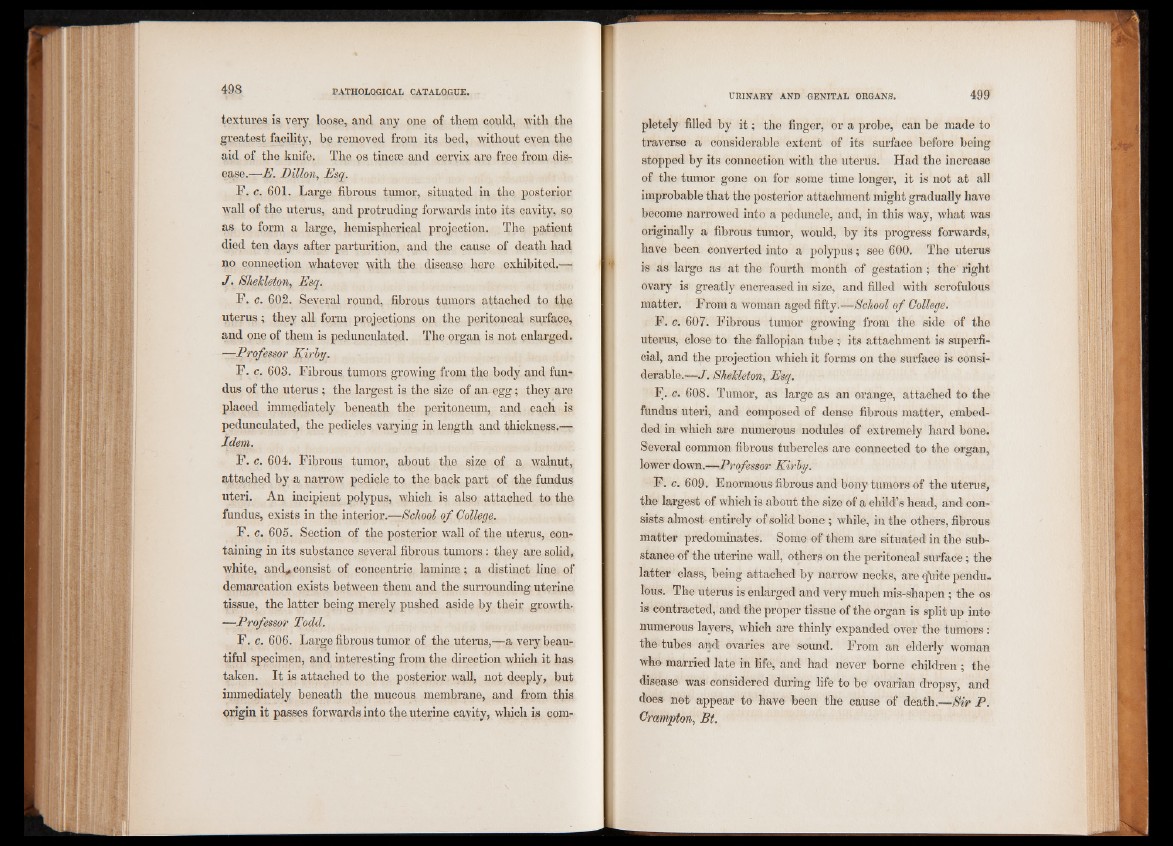
textures is very loose, and any one of them could, with the
greatest facility, be removed from its bed, without even the
aid of the knife. The os tincae and cervix are free from disease.—
E. Dillon, Esq.
F. c. 601. Large fibrous tumor, situated in the posterior
wall of the uterus, and protruding forwards into its cavity, so
as to form a large, hemispherical projection. The patient
died ten days after parturition, and the cause of death had
no connection whatever with the disease here exhibited.—
J. Shehleton, Esq.
F. c. 602. Several round, fibrous tumors attached to the.
uterus; they all form projections on the peritoneal surface,
and one of them is pedunculated. The organ is not enlarged.
—-Professor Kirby.
F • c. 603. Fibrous tumors growing from the body and fundus
of the uterus ; the largest is the size of an egg; they are
placed immediately beneath the peritoneum, and each, is
pedunculated, the pedicles varying in length, and thickness.—
Idem.
F. c. 604. Fibrous tumor, about the size of a walnut,
attached by a narrow pedicle, to the back part of the fundus
uteri. An incipient polypus, which is also attached to the
fundus, exists in the interior.—School of College.
F. c. 605. Section of the posterior wall of the uterus, containing
in its substance several fibrous tumors: they are solid,
white, and,» consist of concentric laminse; a distinct line of
demarcation exists between them and the surrounding uterine
tissue, the latter being merely pushed aside by their growth-
—Professor Todd.
F. c. 606. Large fibrous tumor of the uterus,—a very beautiful
specimen, and interesting from the direction which it has
taken. It is attached to the posterior wall, not deeply, but
immediately beneath the mucous membrane, and from this
origin it passes forwards into the uterine cavity, which is completely
filled by it ; the finger, or a probe, can be made to
traverse a considerable extent of its surface before being
stopped by its connection with the uterus. Had the increase
of the tumor gone on for some time longer, it is not at all
improbable that the posterior attachment might gradually have
become narrowed into a peduncle, and, in this way, what was
originally a fibrous tumor, would, by its progress forwards,
have been converted into a polypus ; see 600. The uterus
is as large as at the fourth month of gestation ; the' right
ovary is greatly encreased in size, and filled with scrofulous
matter. From a woman aged fifty.—School of College.
F. c. 607. Fibrous tumor growing from the side of the
uterus, close to the fallopian tube ? its attachment is superficial,
and the projection which it forms on the surface is considerable.—/.
Skekleton, Esq.
F. c. 608. Tumor, as large as an orange, attached to the
fundus uteri, and composed of dense fibrous matter, embedded
in which are numerous nodules of extremely hard bone.
Several common fibrous tubercles are connected to the organ,
lowerdown.—Professor Kirby.
F. c. 609. Enormous fibrous and bony tumors of the uterus,
the largest of which is about the size of a child’s head, and consists
almost entirely of solid bone ; while, in the others, fibrous
matter predominates. Some of them are situated in the substance
of the uterine wall, others on the peritoneal surface ; the
latter class, being attached by narrow necks, are q'uite pendu,
lous. The uterus is enlarged and very much mis-shapen ; the os
is contracted, and the proper tissue of the organ is split up into
numerous layers, which are thinly expanded over the tumors :
the tubes and ovaries are sound. From an elderly woman
who married late in life, and had never borne children ; the
disease was considered during life to be ovarian dropsy, and
does not appear to have been the cause of death.—Sir P.
Crampton, Bt.